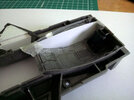JimmyB
Active Member
So the thinking was Jawas found a crashed ETA-2 Actis in the sand dunes of Tatooine and sold it to everyone's favourite mechanic in Mos Eisley's Hangar 3-5, to be butchered and upgraded to hyperspace-capable by Peli Motto's long suffering pit droids.
Here's the basic design, done in Blender using a fortuitous 3D scan of the Hasbro toy which can be found on Thingiverse. The blue box poking out at the bottom will be a battery box made to look guts-on-the-outside (more on that later... hopefully).

From the 3D model I figured out how to scale the UV maps of the meshes for printing on A4 paper as cutting plans, which are then stuck to styrene sheet using 3M spray adhesive. Here's a sample layout to show you what I mean.

Then it was time to start hacking away at the Hasbro Actis. Here are the casualties.

And here are the beginnings of a beautiful experience (despite the cuts and expletives the neighbours probably heard). Yes, that's a cheap toothbrush from Boots converted into a battery powered oscillating sander with removable velcro sanding discs cut from sheet sandpaper.

I didn't want a droid sticking out of the wing for this, so I hacked out and filled the hole, and then made another hole for a custom greeble that'll be sticking out of the wing
The solar panels were also a write off when the Jawas found it, so I hacked away at them to create holes that match the toy's holes in the main part of the wing. That was fun (sarcasm).

More to come later.
Here's the basic design, done in Blender using a fortuitous 3D scan of the Hasbro toy which can be found on Thingiverse. The blue box poking out at the bottom will be a battery box made to look guts-on-the-outside (more on that later... hopefully).
From the 3D model I figured out how to scale the UV maps of the meshes for printing on A4 paper as cutting plans, which are then stuck to styrene sheet using 3M spray adhesive. Here's a sample layout to show you what I mean.
Then it was time to start hacking away at the Hasbro Actis. Here are the casualties.
And here are the beginnings of a beautiful experience (despite the cuts and expletives the neighbours probably heard). Yes, that's a cheap toothbrush from Boots converted into a battery powered oscillating sander with removable velcro sanding discs cut from sheet sandpaper.
I didn't want a droid sticking out of the wing for this, so I hacked out and filled the hole, and then made another hole for a custom greeble that'll be sticking out of the wing
The solar panels were also a write off when the Jawas found it, so I hacked away at them to create holes that match the toy's holes in the main part of the wing. That was fun (sarcasm).
More to come later.

